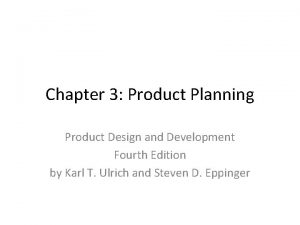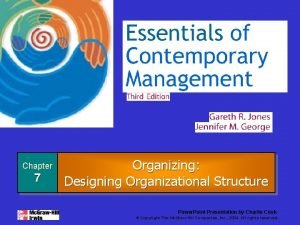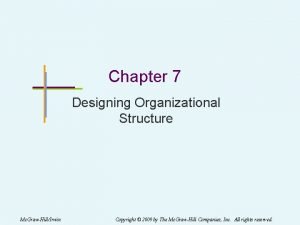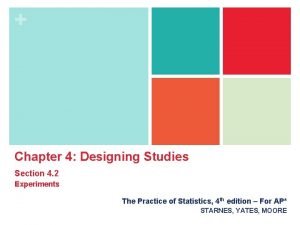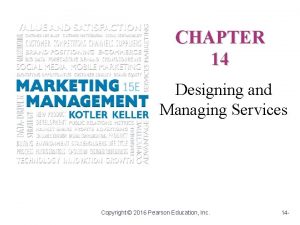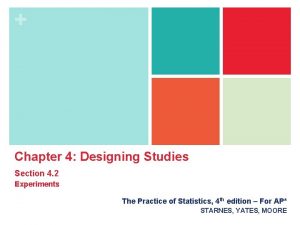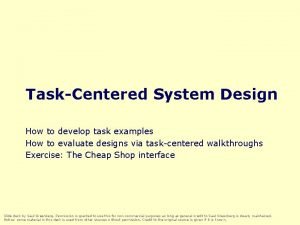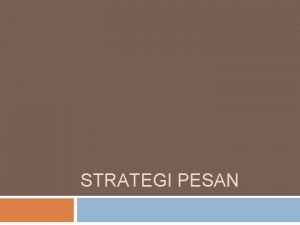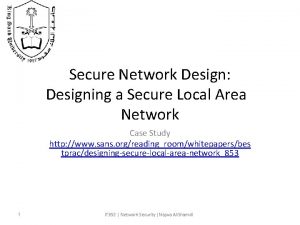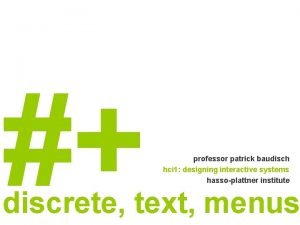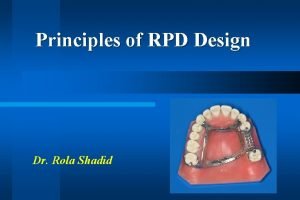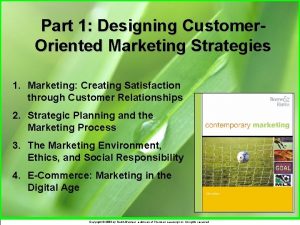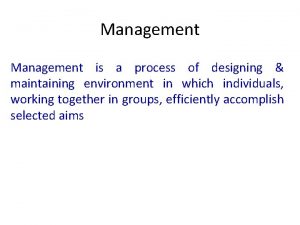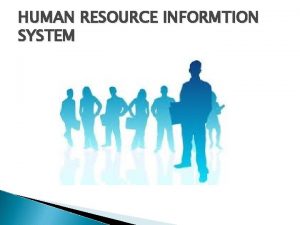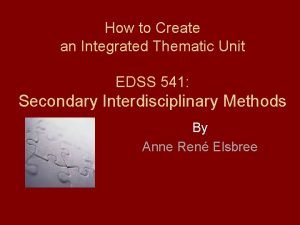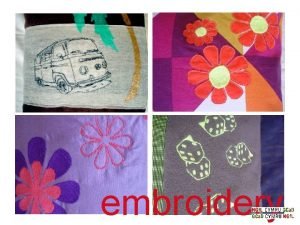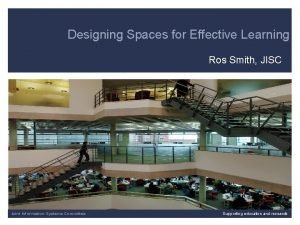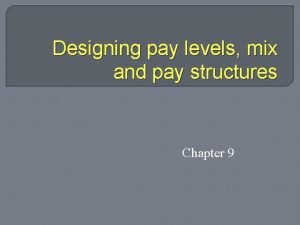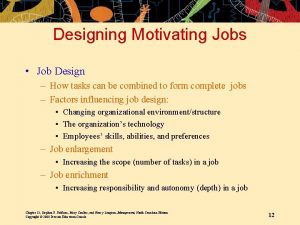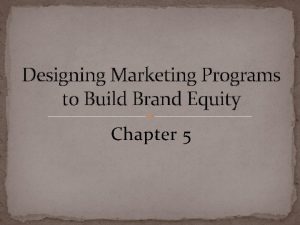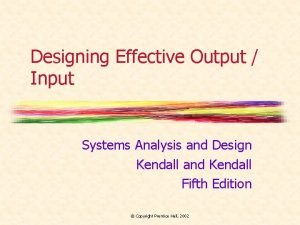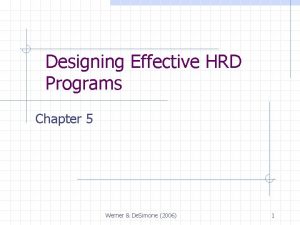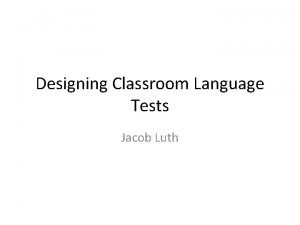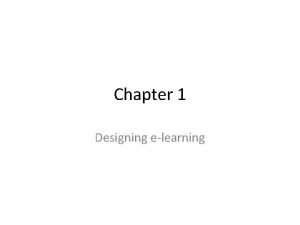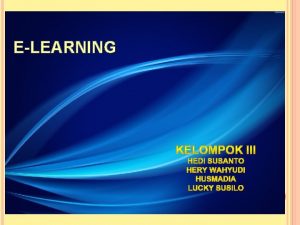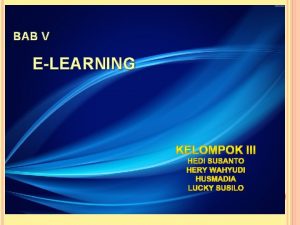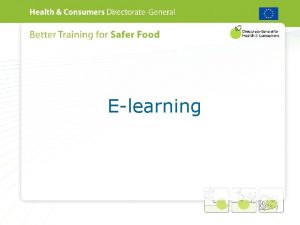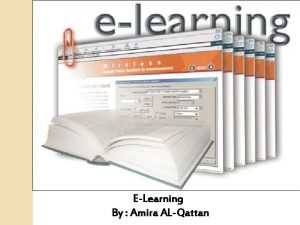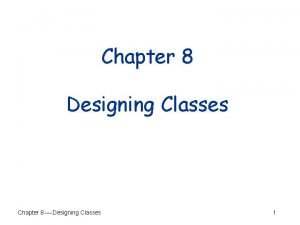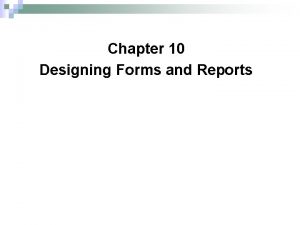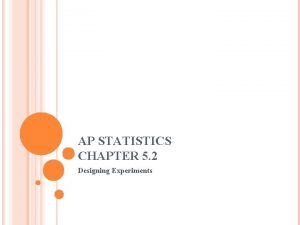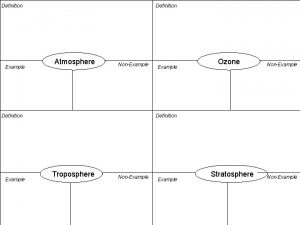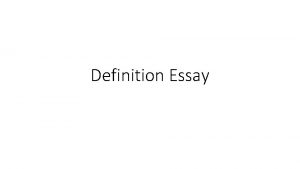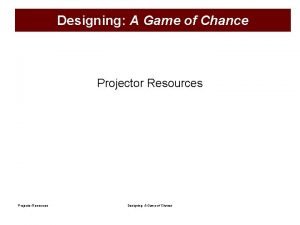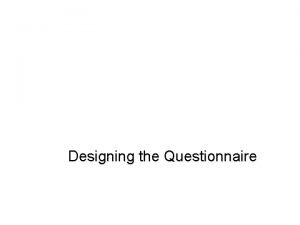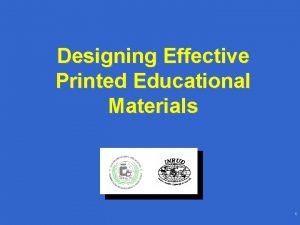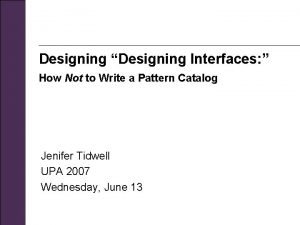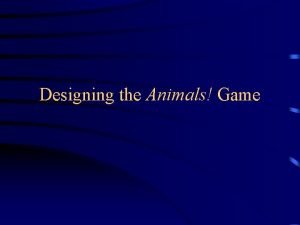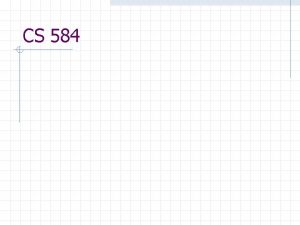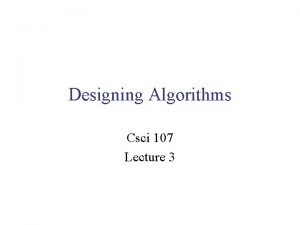Chapter 1 Designing elearning Definition of elearning Elearning



























- Slides: 27

Chapter 1 Designing e-learning

Definition of e-learning E-learning is the use of electronic technologies to create learning experience.

Types of e-learning courses A course with some on-line elements A Hybrid Course A course taught entirely online Identify this in the written part of your project

What is instructional design? includes • Goals • Teaching strategies • Content • Technology choices Explain these in the written part of your project

General Steps 1. Identify your main goals (Goals of the course- based on standards, curriculum- ) 2. 3. 4. Analyze learners’ need (what type of students? ) Identify what to teach (based on your experience and #1) Set learning objectives (Goals of the lesson- more specific than goals) 5. Identify prerequisites 6. Pick the approach to meet each objective (general approach for each objective (e, g, . Slide 16) 7. Decide the teaching sequence of your objectives 8. Create learning objects to accomplish objectives A. B. C. Create tests Select learning activities Choose media

1 - Identify your main goals Types of goals 1. Financial 2. Intellectual (educational) 3. Costumers 4. Employees 5. Operations (improving efficiency) 6. Reputation

2 -Analyze learners’ need 1. 2. 3. 4. 5. 6. 7. 8. 9. 10. 11. 12. 13. Motivation for learning Psychomotor skills Attitude and mindset (dispositions) Mental discipline (ability to recognize and respond wisely) Communication skills Social skills Talents and intelligences Media preferences Background knowledge and experience Learning conditions Locus of control Style of prior education Digital fluency Include this in your written part of the project

3 -Identify what to teach (Education) 1. Identify essentials (curriculum and standards) 2. Analyze the gap between real and ideal performance (what they need for their future job) - [Design for how People Learn (2012), by Julie Dirksen. ] 3. Analyze How people learn (learning theories) Telling Ain't Training 2 nd edition By Harold D. Stolovitch, Erica Keeps 4. Ask “those who should know” (best practices – online resources BUT don’t blindly copy) 5. Analyze critical incidents (academic failures) 6. Don’t let the “content committee” decide (don’t blindly follow them. Rely on your own experience and abilities)

4 - Set learning objectives

Good Objectives • Clear • Specific • Worthy

Good Bad Objectives • Bad -The student will understand the processes of inductive and deductive reasoning • Good - The student will listen to several letters read from the editorial page of a newspaper or magazine. He/she will participate in a discussion about the type of logic employed, the effectiveness of the evidence, and the validity of the argument.

Good Bad Objectives • Bad - Students have the ability to take new information and break it down into parts to differentiate between them. • Good - Students will read a presidential debate and point out the passages that attack a political opponent personally rather than the opponent’s political programs.

Good Bad Objectives • Bad : “student can say goodbye in German” • Good: student can say at least 10 common words in German.

Primary and secondary objectives Primary • Create (has to be original; not from scratch; could be an object, a concept, a plan) • Decide (going beyond following procedures / making judgment or decision based on what is known) • Do (performing a procedure without having to make decisions, procedures could be mental or physical) Secondary • Know (recall, knowing how to find, knowing how things work) • Believe (the learner is convinced that…) • Feel (how students will feel about…/ how confident they are)

5 - Identify prerequisites • Why learners may fail to accomplish the objective.

6 - Pick the approach to meet each objective chapters 2 -4 1. 2. 3. 4. 5. 6. 7. 8. 9. 10. Standalone e-learning Games and simulations Virtual-classroom e-learning Physical-classroom learning Coaching (mentoring-tutoring) Referring to learning resources Searching online resources Interacting with a social network Letting learners find the solution on their own Changing external factors (in some organizations, often, the best way to meet an objective is not learning what others do. try to change the rules/standards)- 11. Blending if necessary

7 - Decide the teaching sequence of your objectives • Bottom up (teach basics first then show the whole picture) • Top down (show the whole picture first, then teach details) • Sideways (learners choose how to start and continue)

8 - Create objects to accomplish objectives A learning object is a chunk of electronic content that can be accessed individually and that completely accomplishes a single learning objective and can prove it.

Features of Learning Objects • May contain text, graphics, animation, video, voice, music, and other media • Can be accessed individually through a menu, search engine, or just a “next button” • Appears to the learner to be separate from other objects • Completely accomplishes a single learning objective • Contains the means to verify that the objective was met. • Can serve multiple purposes and may contain other learning objects.

Steps of designing learning objects • A- Create Tests • B- Select learning activities • C. Choose Media

Select learning activities To accomplish learning objectives, we typically require 3 types of learning activities: • Absorb • Do • Connect

Examples of Absorb • • Presentations Readings Stories by the teacher Field trips

Examples of Do • Practice by applying their skills • Discovery (experimenting and exploring) • Games and simulations ( discovery in a safe environment, gain insight, and confidence)

“Connect” activities Connect what they are learning to their work, their lives, and their prior knowledge

Examples of Connect • Ponder (stop and think about the subject more broadly and deeply) • Questioning (let learners ask questions and obtain answers to their individual questions) • Stories told by students (requires learners to share their experiences) • Job aids (checklists, manuals, glossaries, calculators, templates, models) • Research (identify learning resources on their own)

C- Choose Media • Each object may require a different mix of text, graphics, sound, voice, music, animation, and video. • What medium is essential to accomplish my objective? • What medium could you not do without?

Compare ADDIE with Horton’s model ADDIE Horton Analyze Design Develop Implement Build Evaluate Test
 Product platform planning
Product platform planning Designing and managing service processes
Designing and managing service processes Chapter 7 designing organizational structure
Chapter 7 designing organizational structure Chapter 7 designing organizational structure
Chapter 7 designing organizational structure Chapter 4 designing studies
Chapter 4 designing studies Designing and managing services kotler keller ppt
Designing and managing services kotler keller ppt Channel design definition
Channel design definition Chapter 4 designing studies
Chapter 4 designing studies Task centered approach example
Task centered approach example Emosional adalah
Emosional adalah How to secure a local area network
How to secure a local area network Patrick is designing a large
Patrick is designing a large Rpd design
Rpd design Marketing environment framework
Marketing environment framework Strategic choices in internal alignment design
Strategic choices in internal alignment design The process of designing and maintaining an environment
The process of designing and maintaining an environment Defintion of hr
Defintion of hr Interdisciplinary thematic units
Interdisciplinary thematic units You are designing a sticker to advertise your band
You are designing a sticker to advertise your band Computer aided embroidery and designing
Computer aided embroidery and designing Marketing channel design example
Marketing channel design example Ros smith
Ros smith Designing a pay structure
Designing a pay structure Designing motivating jobs
Designing motivating jobs Designing marketing programs
Designing marketing programs Designing effective input
Designing effective input Designing effective hrd programs pdf
Designing effective hrd programs pdf Designing classroom language tests
Designing classroom language tests
